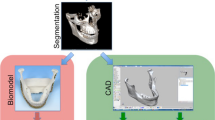Abstract
Purpose
For the new generation of mandibular reconstruction, patient-specific mandible reconstruction plates (PSMPs) have been developed which are milled from titanium after preoperative computer planning using CAD/CAM procedures. Resection margins and plate position are determined by surgical guides. In addition, length and shape of the plate and the number and angulation of the screw holes can be planned.
Methods
30 patients received such PSMP. Indication ranged from stabilization osteosynthesis, single alloplastic stand-alone reconstruction to microvascular reconstructions. Time for planning, fit of surgical guides and plates, pre-/postoperative occlusion, radiological position of the temporo mandibular joint and complications were recorded.
Results
The median time for online planning was 35 min. The results concerning fit and handling of the PSMP and the surgical guides were mainly very positive. In six cases, the plan had to be adapted to the intraoperative clinical needs. The postoperative position of the condyles in the temporo mandibular fossae was regular in 28 cases. The evaluation of the occlusion was not representative due to not clearly identifiable occlusion in 2/3 of the cases. Nevertheless, complications like postoperative extraoral plate exposure, infection, graft and flap necrosis or difficulties to position the guides or the plate during surgery occurred.
Conclusions
Mandibular reconstruction with PSMP offers a broad range of opportunities and benefits compared with standard procedures and can be recommended for all kind of mandibular reconstructions. It is not yet foreseeable whether PSMP will in future become routine clinical practice for mandibular reconstruction or will be confined to selected isolated cases.








Similar content being viewed by others
References
Hallermann W, Olsen S, Bardyn T, Taghizadeh F, Banic A, Iizuka T (2006) A new method for computer-aided operation planning for extensive mandibular reconstruction. Plast Reconstr Surg 117:2431–2437
Farwell D, Futuran N (2000) Oromandibular reconstruction. Facial Plast Surg 16:115–126
Baker A, McMahon J, Parmar S (2001) Immediate reconstruction of continuity defects of the mandible after tumor surgery. J Oral Maxillofac Surg 59:1333–1339
Schimmele S (2001) Delayed reconstruction of continuity defects of the mandible after tumor surgery. J Oral Maxillofac Surg 59:1340–1344
Schraag C, Yang-Ming C, Chi-Ying T, Fu-Chan W (2006) Complete rehabilitation of the mandible following segmental resection. J Surg Oncol 94:538–545
Wilde F, Winter K, Kletsch K, Lorenz K, Schramm A (2015) Mandible reconstruction using patient-specific pre-bent reconstruction plates: comparison of standard and transfer key methods. Int J Comput Assist Radiol Surg 10:129–140
Toro C, Robiony M, Costa M, Zerman N, Politi M (2007) Feasibility of preoperative planning using anatomical facsimile models for mandibular reconstruction. Head Face Med 15(3):5
Wilde F, Plail M, Riese C, Schramm A, Winter K (2011) Mandible reconstruction with patient-specific pre-bent reconstruction plates: comparison of a transfer key method to the standard method - results of an in vitro study. Int J Comput Assist Radiol Surg 7:57–63
Wilde F, Cornelius C-P, Schramm A (2014) Computer-assisted mandibular reconstruction using a patient-specific reconstruction plate fabricated with computer-aided design and manufacturing techniques. Craniomaxillofac Trauma Reconstr 7:158–166
ProPlan CMF Scanning Protocol (2014) http://sites.synthes.com/intl/css/proplan/Pages/Downloads.aspx. Accessed 14 Oct 2014
ProPlan CMF Request for Service—Mandible and midface reconstruction (2014) http://sites.synthes.com/intl/css/proplan/Pages/Downloads.aspx Accessed Oct 2014
Essig H, Rana M, Kokemueller H, von See C, Ruecker M, Tavassol F, Gellrich NC (2011) Pre-operative planning for mandibular reconstruction—a full digital planning workflow resulting in a patient specific reconstruction. Head Neck Oncol 3:45
Freudlsperger C, Bodem JP, Engel E, Hoffmann J (2014) Mandibular reconstruction with a prefabricated free vascularized fibula and implant-supported prosthesis based on fully three-dimensional virtual planning. J Craniofac Surg 25:980–982
Hellem S, Olofsson J (1988) Titanium-coated hollow screw and reconstruction plate system (THORP) in mandibular reconstruction. J Craniomaxillofac Surg 16:173–183
Vuillemin T, Raveh J, Sutter F (1988) Mandibular reconstruction with the titanium hollow screw reconstruction plate (THORP) system: evaluation of 62 cases. Plast Reconstr Surg 82:804–814
Wilde F, Cornelius C-P, Mascha F, Heufelder M, Schramm A (2012) Computerassistierte Unterkieferrekonstruktion unter Verwendung CAD/CAM gefertigter patientenspezifischer Unterkieferrekonstruktionsplatten. Eine Kadavermachbarkeitsstudie. Poster presentation, 62. Congress of the German Society of Oral-Maxillo-Facial-Surgery (DGMKG e.V.), 31 May–2 June 2012, Freiburg i. Brsg, Germany
Wilde F, Cornelius C-P, Schramm A (2013) Computer-assisted mandibular reconstruction with CAD/CAM-fabricated patient-specific reconstruction plates: a cadaver feasibility study. Int J Comput Assist Radiol Surg 8(Suppl 1):87–88
Modabber A, Ayoub N, Möhlhenrich SC, Goloborodko E, Sönmez TT, Ghassemi M, Loberg C, Lethaus B, Ghassemi A, Hölzle F (2014) The accuracy of computer-assisted primary mandibular reconstruction with vascularized bone flaps: iliac crest bone flap versus osteomyocutaneous fibula flap. Med Devices (Auckl) 7:211–217
Crawford S (1999) Condylar axis position, as determined by the occlusion and measured by the CPI instrument, and signs and symptoms of temporomandibular dysfunction. Angle Orthod 69:103–115
Leonard M (1985) Maintenance of condylar position after sagittal split osteotomy of the mandible. J Oral Maxillofax Surg 43:391–392
Leonard M (1976) Preventing rotation of the proximal fragment in the sagittal ramus split operation. J Oral Surg 34:942–942
Seruya M, Fisher M, Rodriguez ED (2013) Computer-assisted versus conventional free fibula flap technique for craniofacial reconstruction: an outcomes comparison. Plast Reconstr Surg 132:1219–1228
Martola M, Lindqvist C, Hänninen H, Al-Sukhun J (2007) Fracture of titanium plates used for mandibular reconstruction following ablative tumor surgery. J Biomed Mater Res B Appl Biomater 80:345–352
Conflict of interest
The authors H.H. and F.P. declare that they have no conflict of interest. Authors F.W. and C.-P.C. were involved in the development process of the presented PSMPs. Authors A.S. and M.H. did honoraria speaking for DePuy/Synthes\(^{\textregistered }\) at symposia.
Author information
Authors and Affiliations
Corresponding author
Rights and permissions
About this article
Cite this article
Wilde, F., Hanken, H., Probst, F. et al. Multicenter study on the use of patient-specific CAD/CAM reconstruction plates for mandibular reconstruction. Int J CARS 10, 2035–2051 (2015). https://doi.org/10.1007/s11548-015-1193-2
Received:
Accepted:
Published:
Issue Date:
DOI: https://doi.org/10.1007/s11548-015-1193-2




